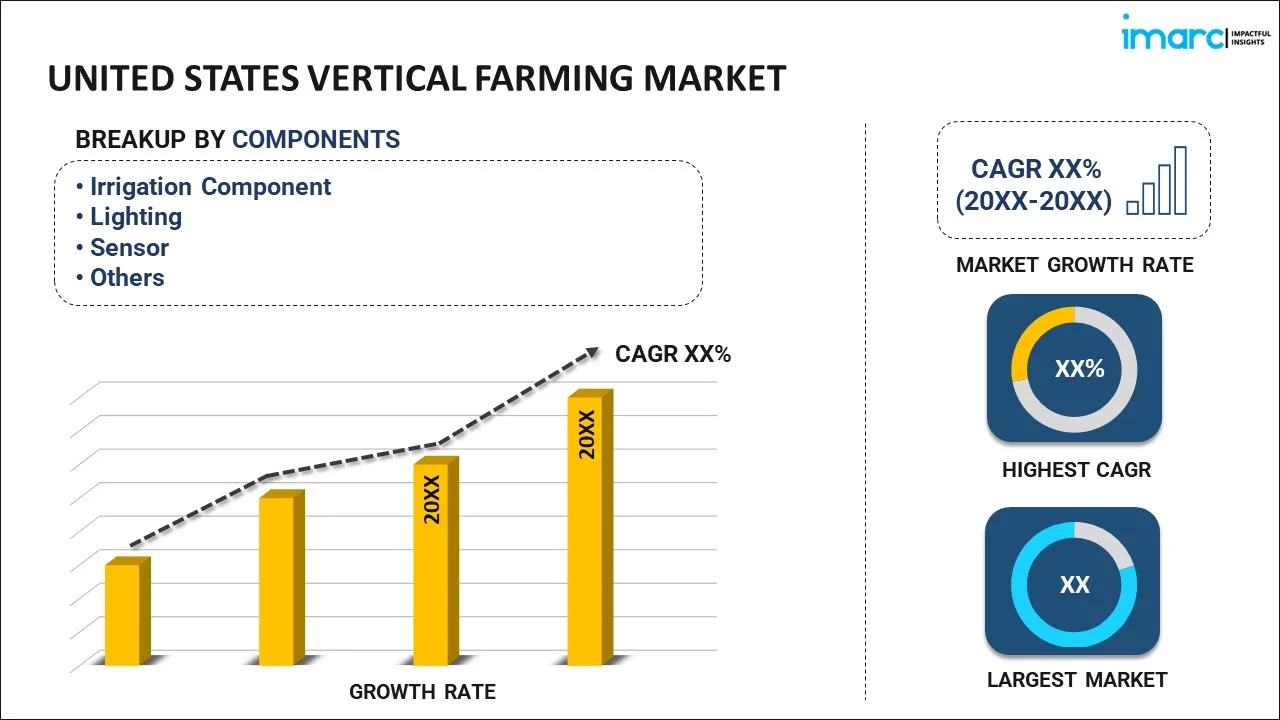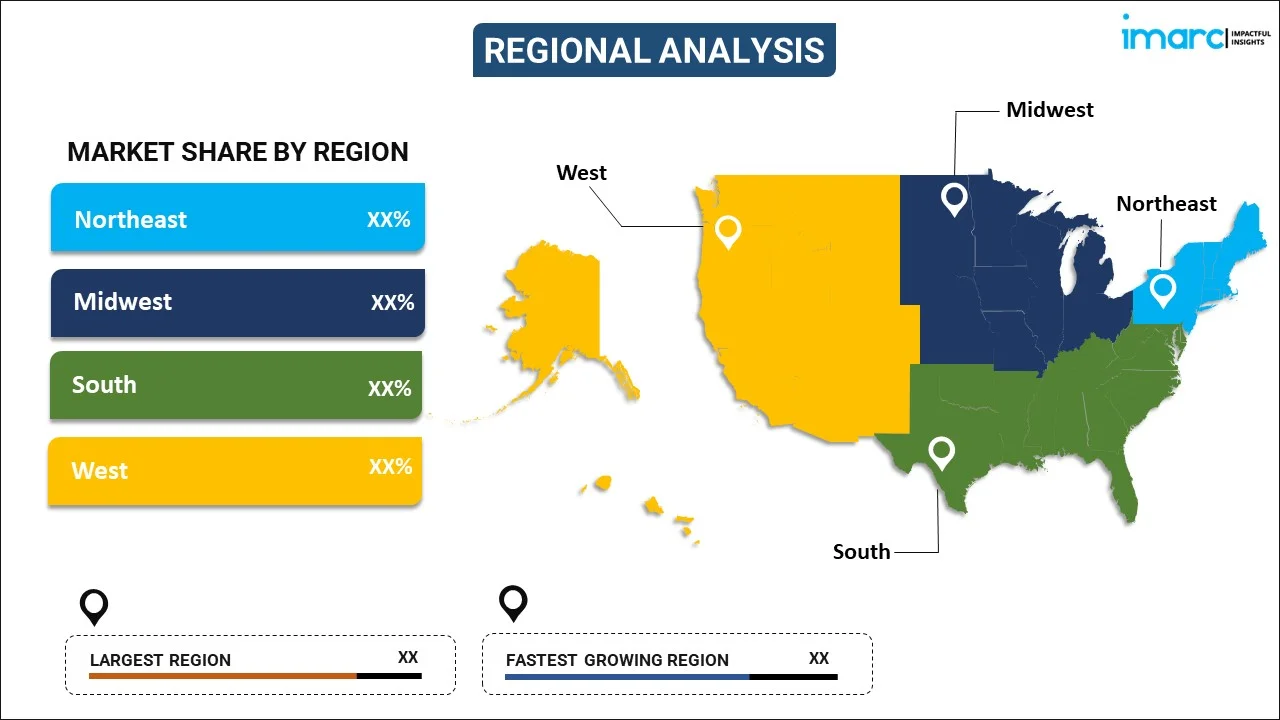
United States Vertical Farming Market Report by Component (Irrigation Component, Lighting, Sensor, Climate Control, Building Material, and Others), Structure (Building-Based Vertical Farms, Container-Based Vertical Farms), Growth Mechanism (Hydroponics, Aeroponics, Aquaponics), Application (Indoor, Outdoor), and Region 2025-2033
Market Overview:
The United States vertical farming market size reached USD 1,678.3 Million in 2024. Looking forward, IMARC Group expects the market to reach USD 4,142.4 Million by 2033, exhibiting a growth rate (CAGR) of 10.56% during 2025-2033. The increasing environmental concern among consumers and businesses, several technological advancements, numerous innovations in LED lighting, automation, and precision agriculture in vertical farms, and the widespread adoption of vertical farming represent some of the key factors driving the market.
|
Report Attribute
|
Key Statistics
|
|---|---|
|
Base Year
|
2024
|
|
Forecast Years
|
2025-2033
|
|
Historical Years
|
2019-2024
|
|
Market Size in 2024
|
USD 1,678.3 Million |
|
Market Forecast in 2033
|
USD 4,142.4 Million |
| Market Growth Rate 2025-2033 | 10.56% |
Vertical farming is a modern agricultural practice that maximizes crop production by stacking plants in vertically layered systems, often within controlled indoor environments. It aims to address the challenges of traditional horizontal farming, such as limited land availability, climate fluctuations, and resource constraints. In a vertical farm, plants are cultivated in stacked trays, shelves, or towers, typically in hydroponic or aeroponic systems, where soil is replaced with nutrient-rich water or mist. LED lighting systems are employed to mimic natural sunlight, allowing crops to thrive year-round, independent of external weather conditions. These controlled environments allow precise management of temperature, humidity, and nutrient levels, optimizing plant growth. It can significantly increase crop yields in a smaller footprint compared to conventional farming, which is valuable in urban areas where arable land is scarce. Additionally, the controlled environment minimizes the need for pesticides and herbicides, making vertical farming more environmentally friendly and sustainable. It also reduces the need for long-distance transportation of produce, as these farms can be established close to urban centers, reducing carbon emissions and ensuring fresher, more nutritious produce reaches consumers. Moreover, the ability to grow numerous crops year-round can enhance food security and provide a source of locally grown, nutritious food.
United States Vertical Farming Market Trends:
The market is primarily driven by the rising environmental concern among consumers and businesses. In addition, vertical farming offers a sustainable alternative to traditional agriculture by minimizing land use and reducing the need for pesticides and herbicides, thus influencing market growth. Also, the growing awareness of climate change and its impacts led consumers to seek out products that are grown in an environmentally friendly manner, which is escalating the demand for produce from vertical farms, which are seen as a greener and more efficient option. Moreover, several technological advancements and numerous innovations in LED lighting, automation, and precision agriculture made it possible to optimize the growing conditions for crops in vertical farms, thus representing another major growth-inducing factor. These technologies enable year-round cultivation, regardless of weather conditions, and allow for precise control over factors such as light, temperature, and humidity. As a result, vertical farms can produce high-quality crops consistently, meeting the demands of consumers and restaurants for fresh, locally-grown produce. Besides this, a shift in consumer preferences toward healthier and more diverse diets led to the adoption of vertical farms well-suited to grow numerous crops, including leafy greens, herbs, and microgreens, which are popular choices for health-conscious consumers and culinary enthusiasts, thus accelerating the market growth. It offers the ability to grow these crops locally and year-round, ensuring a steady supply of fresh and nutritious produce.
United States Vertical Farming Market Segmentation:
IMARC Group provides an analysis of the key trends in each segment of the market, along with forecasts at the country level for 2025-2033. Our report has categorized the market based on component, structure, growth mechanism, and application.
Component Insights:

- Irrigation Component
- Lighting
- Sensor
- Climate Control
- Building Material
- Glass Greenhouse
- Plastic Greenhouse
- Others
The report has provided a detailed breakup and analysis of the market based on the component. This includes irrigation component, lighting, sensor, climate control, building material (glass greenhouse and plastic greenhouse), and others.
Structure Insights:
- Building-Based Vertical Farms
- Container-Based Vertical Farms
A detailed breakup and analysis of the market based on the structure have also been provided in the report. This includes building-based vertical farms and container-based vertical farms.
Growth Mechanism Insights:
- Hydroponics
- Aeroponics
- Aquaponics
The report has provided a detailed breakup and analysis of the market based on the growth mechanism. This includes hydroponics, aeroponics, and aquaponics.
Application Insights:
- Indoor
- Outdoor
A detailed breakup and analysis of the market based on the application have also been provided in the report. This includes indoor and outdoor.
Regional Insights:

- Northeast
- Midwest
- South
- West
The report has also provided a comprehensive analysis of all the major regional markets, which include Northeast, Midwest, South, and West.
Competitive Landscape:
The market research report has also provided a comprehensive analysis of the competitive landscape. Competitive analysis such as market structure, key player positioning, top winning strategies, competitive dashboard, and company evaluation quadrant has been covered in the report. Also, detailed profiles of all major companies have been provided.
United States Vertical Farming Market Report Coverage:
| Report Features | Details |
|---|---|
| Base Year of the Analysis | 2024 |
| Historical Period | 2019-2024 |
| Forecast Period | 2025-2033 |
| Units | Million USD |
| Scope of the Report | Exploration of Historical and Forecast Trends, Industry Catalysts and Challenges, Segment-Wise Historical and Predictive Market Assessment:
|
| Components Covered |
|
| Structures Covered | Building-Based Vertical Farms, Container-Based Vertical Farms |
| Growth Mechanisms Covered | Hydroponics, Aeroponics, Aquaponics |
| Applications Covered | Indoor, Outdoor |
| Regions Covered | Northeast, Midwest, South, West |
| Customization Scope | 10% Free Customization |
| Post-Sale Analyst Support | 10-12 Weeks |
| Delivery Format | PDF and Excel through Email (We can also provide the editable version of the report in PPT/Word format on special request) |
Key Questions Answered in This Report:
- How has the United States vertical farming market performed so far and how will it perform in the coming years?
- What has been the impact of COVID-19 on the United States vertical farming market?
- What is the breakup of the United States vertical farming market on the basis of component?
- What is the breakup of the United States vertical farming market on the basis of structure?
- What is the breakup of the United States vertical farming market on the basis of growth mechanism?
- What is the breakup of the United States vertical farming market on the basis of application?
- What are the various stages in the value chain of the United States vertical farming market?
- What are the key driving factors and challenges in the United States vertical farming?
- What is the structure of the United States vertical farming market and who are the key players?
- What is the degree of competition in the United States vertical farming market?
Key Benefits for Stakeholders:
- IMARC’s industry report offers a comprehensive quantitative analysis of various market segments, historical and current market trends, market forecasts, and dynamics of the United States vertical farming market from 2019-2033.
- The research report provides the latest information on the market drivers, challenges, and opportunities in the United States vertical farming market.
- Porter's five forces analysis assist stakeholders in assessing the impact of new entrants, competitive rivalry, supplier power, buyer power, and the threat of substitution. It helps stakeholders to analyze the level of competition within the United States vertical farming industry and its attractiveness.
- Competitive landscape allows stakeholders to understand their competitive environment and provides an insight into the current positions of key players in the market.
Need more help?
- Speak to our experienced analysts for insights on the current market scenarios.
- Include additional segments and countries to customize the report as per your requirement.
- Gain an unparalleled competitive advantage in your domain by understanding how to utilize the report and positively impacting your operations and revenue.
- For further assistance, please connect with our analysts.
 Request Customization
Request Customization
 Speak to an Analyst
Speak to an Analyst
 Request Brochure
Request Brochure
 Inquire Before Buying
Inquire Before Buying




.webp)




.webp)












